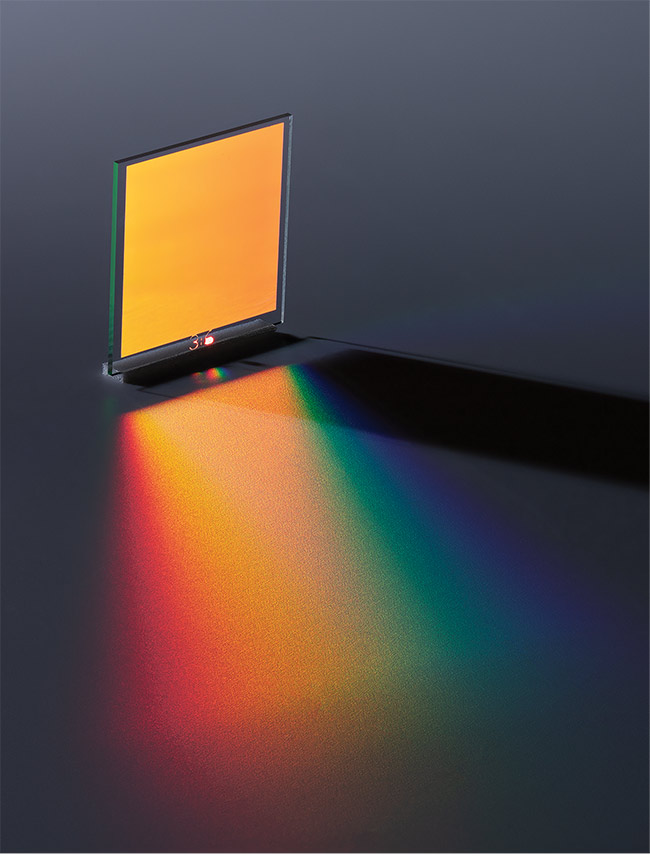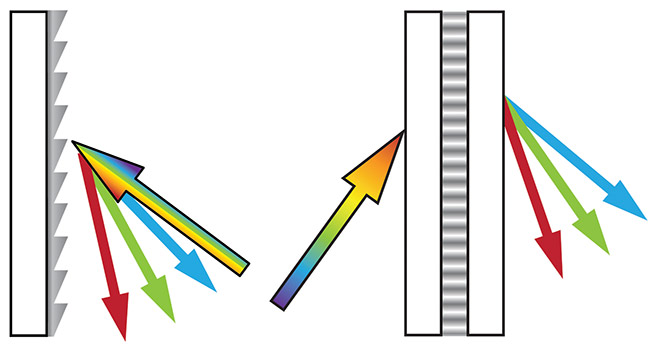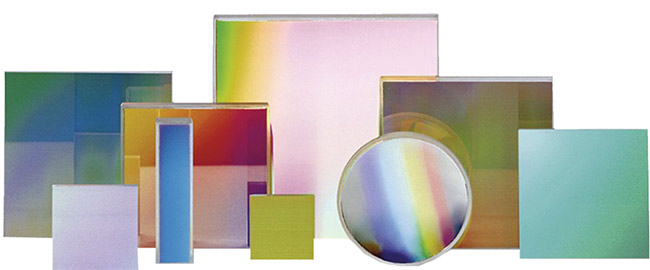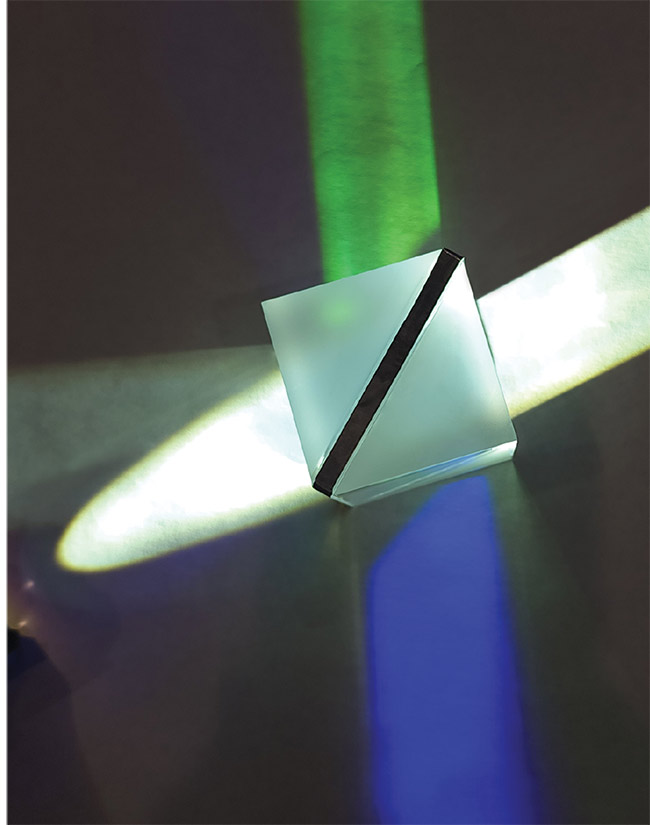Trends toward smaller spectrometers and nonmechanical lidar are calling for new dispersive elements with denser lines and designs.
HANK HOGAN, CONTRIBUTING EDITOR
Because they separate light into its spectral components, diffraction gratings lie at the heart of modern spectrometers, hyperspectral imagers, optical coherence tomography systems, and similar instruments. In the future, gratings may improve automotive lidar, a market that could reach tens of millions of units annually. Gratings have also played a role in reducing the footprint of spectrometers in the last few years, vastly expanding their market by enabling more compact and mobile devices.

A surface relief grating on fused silica. Courtesy of Ibsen Photonics.
Advancements in grating design and manufacturing promise more efficient
optical throughput. Application needs will still determine grating selection, though, so grating fundamentals will continue to be paramount.
Separating light
As early as the 1700s, scientists recognized the utility of separating light into its constituent colors for analysis. The first spectrometers used prisms, typically triangular pieces of glass, to separate the solar spectrum for study. Prisms are still useful today when spectral separation requirements are not exacting. But by the mid-1800s, scientists had already begun turning toward diffraction gratings, which offer more efficient throughput across a wider range of wavelengths and render more distinct spectral separation angles to deliver higher spectral resolution. Gratings also operate across a wider range of wavelengths.
Diffraction gratings achieve these effects through periodic structures that act similarly to a series of slits. These features cause incoming light to separate into its constituent colors, giving rise to a rainbow pattern.
“We make rainbows using Jell-O sandwiches,” said Elroy Pearson, a senior optical engineer at Wasatch Photonics.
The rainbow effect is common to all gratings, but the “sandwiches” to which Pearson refers are the company’s volume phase holographic gratings, which comprise layers of gelatin sealed between two rigid plates. The design of these gratings stands in contrast to the more widely used grating type consisting of ruled lines or grooves on a surface. The volume phase diffraction technique enabled by Wasatch’s sandwiches uses high- and low-index refraction regions and allows control of both line density and index differences.

Two types of gratings. A surface relief grating reflects and disperses incoming light into constituent colors (left). A volume phase holographic grating transmits and disperses incoming light (right). Courtesy of Wasatch Photonics.
Regardless of the construction method or material, the diffraction process resulting from the periodic structures enables modern spectroscopy and hyperspectral imaging systems. It is also used in applications where one wavelength, such as a telecom signal, is crucial but others are
irrelevant or detrimental. A grating offers a more compact option than the use of multiple tight bandwidth filters in situations where 40 or 80 telecom channels must be selected and separated from one another.
Application defines design
The design of an optical system drives the selection of a particular grating type, said Craig Hanson, senior product manager for Richardson Gratings at MKS Instruments, which makes both mechanically ruled and holographically patterned primary gratings.
“Foremost is determining if you are using a grating in reflection or transmission,” Hanson said.
A reflective grating can act as a folding mirror and thereby reduce the overall size of an optical instrument. The gratings’
designs also make them effective in spectral regions where their base material
absorbs light. For example, glass and resin gratings can reflect UV wavelengths. It is important in such applications to align the incoming beam with the grating’s grooves to optimize the grating’s performance. Also, drift due to temperature changes can affect instrument maintenance and operation.
A transmission grating reduces temperature concerns by allowing the optical system to better compensate for aberrations while enabling a diffracted signal with high efficiency and low sensitivity to polarization. However, the spectral resolving power of transmission gratings may be lower than those of reflection gratings because the path difference
between neighboring beams is smaller.

Gratings come in various shapes and sizes as a result of different manufacturing methods.
Courtesy of MKS Instruments.
A grating manufacturer can help instrumentation developers to balance
the competing demands of resolution,
efficiency, cost, and delivery time.
“If you get it right, then you’ll get high-performing, high-yield, unit-to-unit-repeatable devices,” said Kristian Buchwald, vice president of gratings at Ibsen Photonics, which makes fused silica surface relief transmission gratings.
Ryan Pasakinskas, technical inside sales lead at ruled-grating maker OPCO Laboratory, said the main considerations driving grating design are optimizing efficiency and minimizing stray light. “Traditionally, a ruled grating offers higher efficiency while a holographic grating offers less stray light,” he said.
When a grating disperses light, it does so in orders. The direction the original beam would have taken if the grating were a simple mirror or lens is the zeroth order, and each additional order disperses at an angle relative to that direction.
Thus, the grating creates multiple outgoing beams. But most applications use only one (typically the first order). Instrument design must account for the other orders, or their unwanted light will degrade system performance.
The use case drives the grating design, but even small application changes can affect performance. For example, MKS’ Hanson recalled one customer who had designed a grating to manage visible light in an instrument and then had expanded the instrument’s spectral range into the UV. The greater spectral coverage increased scattering and reduced the signal-to-noise ratio, necessitating adjustments in the grating.
Expressed in lines per millimeter, line density has a direct effect on the dispersion performance of a grating. Higher line densities translate into higher dispersion, which means a larger angular separation of wavelengths. In practical terms, gratings with higher line densities allow more compact designs with a wide wavelength range, or designs offering higher resolution within a very narrow wavelength range.
Conventional ruling engines, devices that scribe lines in a substrate, create gratings with 300, 600, 1200, or 2400 lines per millimeter. Interferometric positioning of ruling engines is now enabling manufacturers to dial in line densities that were not previously achievable.
“This allows for custom groove spacing and therefore custom dispersion,” OPCO’s Pasakinskas said. Custom spacing could open up new applications, he said, by enabling grating line densities tailored to the needs of a specific application rather than forcing systems designers to make do with conventional line densities. This capability, in turn, would support greater latitudes for system-level design.
Wasatch Photonics’ Pearson said grisms, which are compound optical elements comprising a grating and a prism, are another development in dispersive optics. Conventional prisms deflect violet wavelengths more than red, while conventional gratings exhibit the opposite bias. By combining both optical elements, grisms capitalize on their dispersive capabilities while canceling out their native beam deviations. They often offer compact, prealigned alternatives to more complex optical assemblies.
To illustrate the capabilities of grisms, Pearson described a recent prototype designed for a high-resolution spectrometer. Typically, he said, a UV-VIS or VIS-NIR spectrometer might cover a spectral band of more than 500 nm using a grating with fewer than 1000 lines per millimeter. The new design used a grism with a line density of 5422 lines per millimeter to achieve more than 5× the dispersion of a typical instrument over a spectral band measuring less than 5 nm. The grism design was optimized for this application and eliminated alignment issues because of its nature as a compound element.
Efficiency in small packages
As emerging spectrometers are made smaller, developers face design and performance challenges. Among them is the geometric limit of the grating. The ability to diffract light is related to the number of grooves per millimeter. A grating with low lines per millimeter may deliver less intensity in its targeted diffracted order, Hanson said. As a spectrometer shrinks, designers may need to adjust line density and other grating parameters accordingly to maintain resolution with smaller dispersive elements.

A high-dispersion grating prism, or grism. The dark diagonal line is the grating, and the white triangular structures are the prisms. White light enters the grism at an angle from the left and exits on the right. Blue light is separated from the incoming light and exits from the bottom. The green beam results from the imaging of the grating. Courtesy of Wasatch Photonics.
Automotive lidar is another high-volume application that will benefit from gratings technology. Specifically, gratings enable nonmechanical beam-steering designs, Ibsen’s Buchwald said. Whereas spectroscopy needs broad wavelength coverage to acquire as much relevant signal data as possible, lidar focuses on a narrow band centered on the wavelength of the ranging laser pulse.
To meet demand for compact, high-performance grating designs, Ibsen uses semiconductor manufacturing platforms to fabricate its products. The company’s deep-UV steppers, photolithography, and etching technology can create feature sizes down to 100 nm, allowing for higher line densities, increased spectral dispersion, and smaller spectrometers.
Ibsen’s manufacturing approach offers the added advantages of being scalable, high volume, and low cost, which, Buchwald said, “is a prerequisite to being able to address the automotive lidar application.”
The company’s manufacturing methods produce dispersive elements with higher diffraction efficiency at higher grating resolutions — a benefit for applications in the UV, he said, because the grating line and space period of 200 nm is lower than the wavelength of the light being diffracted.